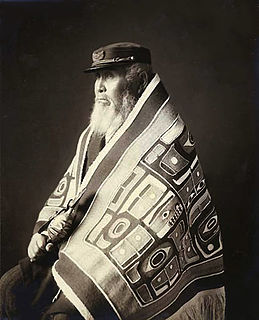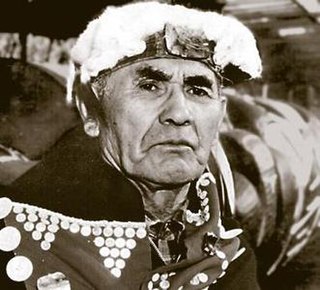This article is about the spiritual beliefs, histories and practices in Kwakwaka'wakw mythology. The Kwakwaka'wakw are a group of Indigenous nations, numbering about 5,500, who live in the central coast of British Columbia on northern Vancouver Island and the mainland. Kwakwaka'wakw translates into "Kwak'wala speaking tribes." However, the tribes are single autonomous nations and do not view themselves collectively as one group.

A potlatch is a gift-giving feast practiced by Indigenous peoples of the Pacific Northwest Coast of Canada and the United States, among whom it is traditionally the primary economic system. This includes the Heiltsuk, Haida, Nuxalk, Tlingit, Makah, Tsimshian, Nuu-chah-nulth, Kwakwaka'wakw, and Coast Salish cultures. Potlatches are also a common feature of the peoples of the Interior and of the Subarctic adjoining the Northwest Coast, though mostly without the elaborate ritual and gift-giving economy of the coastal peoples.

The Kwakwa̱ka̱ʼwakw, also known as the Kwakiutl are Indigenous peoples of the Pacific Northwest Coast. Their current population, according to a 2016 census, is 3,665. Most live in their traditional territory on northern Vancouver Island, nearby smaller islands including the Discovery Islands, and the adjacent British Columbia mainland. Some also live outside their homelands in urban areas such as Victoria and Vancouver. They are politically organized into 13 band governments.

The Tsimshian are an indigenous people of the Pacific Northwest Coast. Their communities are mostly in coastal British Columbia and far southern Alaska, around Terrace and Prince Rupert in British Columbia, and Alaska's Annette Islands. The Tsimshian people consist of approximately 10,000 members of seven First Nations. The Tsimshian are one of the largest First Nations peoples in northwest British Columbia. Some Tsimshian migrated to Annette Island, Alaska, where their descendants in the Metlakatla Indian Community number about 1450.

Wakashan is a family of languages spoken in British Columbia around and on Vancouver Island, and in the northwestern corner of the Olympic Peninsula of Washington state, on the south side of the Strait of Juan de Fuca.
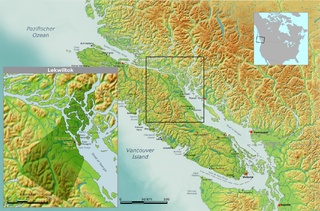
Laich-kwil-tach, is the Anglicization of the Kwak'wala autonomy by the "Southern Kwakiutl" people of Quadra Island and Campbell River in British Columbia, Canada. There are today two main groups : the Wei Wai Kai and Wei Wai Kum just across on the Vancouver Island "mainland" in the town of Campbell River. In addition to these two main groups there are the Kwiakah originally from Phillips Arm and Frederick Arm and the Discovery Islands, the Tlaaluis (Laa'luls) between Bute and Loughborough Inlets—after a great war between the Kwakiutl and the Salish peoples they were so reduced in numbers that they joined the Kwiakah—and the Walitsima / Walitsum Band of Salmon River.
Kwakʼwala, previously known as Kwakiutl, is the indigenous language spoken by the Kwakwakaʼwakw. It belongs to the Wakashan language family. There are fewer than 200 fluent Kwakʼwala speakers today, which amounts to 3% of the Kwakwakaʼwakw population. Because of the small number of speakers, most of whom are elders, as well as the fact that very few if any children learn Kwakʼwala as a first language, its long-term viability is in question. However, interest from many Kwakwakaʼwakw in preserving their language and a number of revitalization projects are countervailing pressures which may extend the viability of the language.

Northwest Coast art is the term commonly applied to a style of art created primarily by artists from Tlingit, Haida, Heiltsuk, Nuxalk, Tsimshian, Kwakwaka'wakw, Nuu-chah-nulth and other First Nations and Native American tribes of the Northwest Coast of North America, from pre-European-contact times up to the present.
The Kwakiutl District Council, also spelled Kwakwewlth District Council and Kwakiuth District Council, pronounced Kwagiulth District Council, is a First Nations Tribal Council based on Vancouver Island in British Columbia, Canada, based in the community of Campbell River, British Columbia in the northern Strait of Georgia but including member nations spanning northern Vancouver Island as far as Quatsino Sound. The nations represented within the Kwakiutl District Council are all Kwakwaka'wakw.

Dzunuḵ̓wa, also Tsonoqua, Tsonokwa, Basket Ogress, is a figure in Kwakwaka'wakw mythology and Nuu-chah-nulth mythology.
The WuikinuxvIPA: [ʔuwik'inuxʷ], also rendered Oowekeeno, Wuikenukv, Wikeno, Owikeno, Oweekano, Awikenox, and also known as the Rivers Inlet people, are an Indigenous First Nations people of the Central Coast region of the Canadian province of British Columbia, located around Rivers Inlet and Owikeno Lake, to the north of Queen Charlotte Strait. The Wuikinuxv people and their neighbours the Heiltsuk and Haisla peoples were in the past sometimes known incorrectly as the "Northern Kwakiutl".
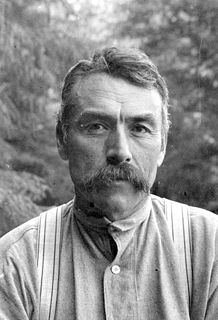
George Hunt (Tlingit) was a consultant to the American anthropologist Franz Boas; through his contributions he is considered a linguist and ethnologist in his own right. He was Tlingit-English by birth and learned both those languages. Growing up with his parents at Fort Rupert, British Columbia in Kwakwaka'wakw territory, he learned their language and culture as well. Through marriage and adoption he became an expert on the traditions of the Kwakwaka'wakw of coastal British Columbia.
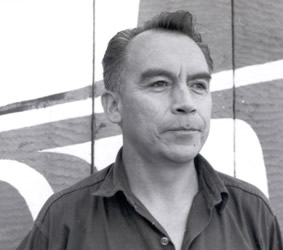
Henry Hunt was a First Nations woodcarver and artist from the Kwakwaka'wakw people of coastal British Columbia.
Calvin Hunt is a Canadian First Nations artist from Fort Rupert, British Columbia. The Kwakiutl are part of the larger nation Kwakwaka'wakw.
The We Wai Kai Nation, also known as the Wewaikai First Nation, the Cape Mudge First Nation and the Cape Mudge Indian Band, is the band government of the We Wai Kai subgroup of the Laich-kwil-tach group of the Kwakwaka'wakw peoples, based on Quadra Island offshore from Campbell River, British Columbia, Canada, which is on the east coast of Vancouver Island at the northern end of the Strait of Georgia. The Laich-kwil-tach include the Wei Wai Kum, who are organized as the Campbell River First Nation, and the Kwiakah Nation, whose traditional territory is in the Discovery Islands to the northeast of that city and on the adjoining mainland coast. All three are part of the Kwakiutl District Council, a tribal council which includes other Kwakwaka'wakw bands farther northwest in the Queen Charlotte Strait region and on northern Vancouver Island.
The Kwiakah First Nation, also known as the Kwiakah Band or Kwiakah Nation, is the band government of the Kwiakah people, a subgroup of the Laich-kwil-tach group of the Kwakwaka'wakw peoples. Their mailing address is in Campbell River, British Columbia, Canada, where most their 19 band members live, although their traditional territory is in the Discovery Islands to the north of that city and their two Indian Reserves are located on the mainland coast adjacent to that archipelago. The band is making an effort to "go back to the land" and re-occupy their traditional sites.
Kwakwaka'wakw music is a sacred and ancient art of the Kwakwaka'wakw peoples that has been practiced for thousands of years. The Kwakwaka'wakw are a collective of twenty-five nations of the Wakashan language family who altogether form part of a larger identity comprising the Indigenous Peoples of the Pacific Northwest Coast, located in what is known today as British Columbia, Canada.

Formline art is a feature in the indigenous art of the Northwest Coast of North America, distinguished by the use of characteristic shapes referred to as ovoids, U forms and S forms. Coined by Bill Holm in his 1965 book Northwest Coast Indian Art: An Analysis of Form, the "formline is the primary design element on which Northwest Coast art depends, and by the turn of the 20th century, its use spread to the southern regions as well. It is the positive delineating force of the painting, relief and engraving. Formlines are continuous, flowing, curvilinear lines that turn, swell and diminish in a prescribed manner. They are used for figure outlines, internal design elements and in abstract compositions."

